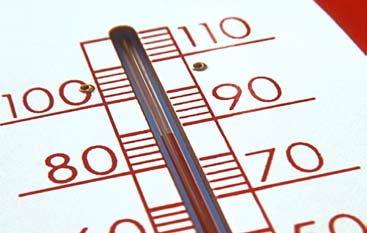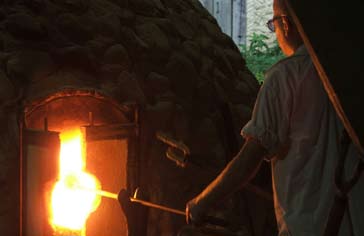JEROME E. SPEAR, CSP, CIH
The effects of heat stress range from simple discomfort to life threatening illnesses such as heat stroke. Aside from the environmental factors (such as temperature, humidity, air movement, and radiant heat), the person’s work regimen and clothing requirements are also factors that determine the risk of heat strain. This paper describes the following three steps to managing heat stress in your workplace:
Step 1: Evaluate Heat Stress to Identify Personnel Who Have a High Risk of Heat Strain
The Wet Bulb Globe Temperature (WBGT) screening criteria established by the American Conference for Governmental Industrial Hygienists (ACGIH) is the most commonly used method of monitoring of potential heat stress.
Step 2: Monitor and Limit Heat Strain for High-Risk Personnel
Simple options for monitoring heat strain include using an ear thermometer to monitor the person’s core temperature and/or issuing heart rate wristwatches to at-risk individuals so they can monitor their heart rate throughout the day.
Step 3: Implement Heat Stress Control Strategies
Consider a combination of engineering controls, administrative and work practice controls, and personal protective equipment to manage heat stress. This step should also be incorporated into Steps 1 and 2 as appropriate.

Step 1: Evaluate Heat Stress
Heat stress is the net heat load to which a worker may be exposed from the combined contributions of metabolic rate required of the work performed, environmental factors (i.e., air temperature, humidity, air movement, and radiant heat exchange), and clothing requirements. Heat strain is the overall physiological response resulting from heat stress. In order to identify tasks or environments that have a high risk of heat stress, the first step is to determine if heat stress screening criteria established by the ACGIH is exceeded. Heat strain (physiological) monitoring is recommended for workers determined to have excessive heat stress.
Heat Stress Screening Criteria
The WBGT is the most widely used heat stress index. Only three measurements are needed to calculate the WBGT – globe temperature, dry bulb temperature, and natural wet bulb temperature. The WBGT is determined by the following equations, depending on if measurements are taken indoors (without a solar load) or outdoors (with a solar load):
Outdoors (with solar load): WBGT = 0.7(WT) + 0.2(GT) + 0.1(DT)
Indoors (without solar load): WBGT = 0.7(WT) + 0.3(GT)
WT = Natural wet bulb temperature
GT = Globe temperature
DT = Air temperature (dry bulb)
Table 1 contains the WBGT screening criteria (in °C) for heat stress recommended by the ACGIH:
Table 1 - WBGT Screening Criteria for Heat Stress

Table reference (ACGIH, 2009)
TLV values represent conditions under which it is believed nearly all heat acclimatized, adequately hydrated, unmedicated, healthy workers may be repeatedly exposed without adverse health effects. A worker may be considered acclimatized for the purposes of the TLV with a recent history of heat-stress exposures of at least two continuous hours (e.g., five of the last seven days to 10 of 14 days). The Action Limit is protective of unacclimatized workers and represents condition for which a heat stress management program should be considered.
The WBGT assumes that the worker is fully acclimatized, light clothing is worn by exposed workers, and employees have adequate water and salt intake. Full-heat acclimatization requires up to three weeks of continued physical activity under heat-stress conditions similar to those anticipated for the work. Acclimatization loss begins when the activity under those heat-stress conditions is discontinued. A noticeable loss in acclimatization occurs after four days. A worker can be considered acclimatized with a recent history of heat stress exposure (i.e., five of the last seven days).
In order to use the WBGT index as the screening criterion, the work pattern and demands must also be considered. As the metabolic rate increases, the WBGT screening criteria must be adjusted. Examples of metabolic rate categories provided by ACGIH (2009) are as follows:
Rest
Sitting.
Light
Sitting with light manual work with hands or hands and arms, and driving. Standing with some light arm work and occasional walking.
Moderate
Sustained moderate hand and arm work, moderate arm and leg work, moderate arm and trunk work, or light pushing and pulling. Normal walking.
Heavy
Intense arm and trunk work, carrying, shoveling, manual sawing; pushing and pulling heavy loads; and walking at a fast pace.
Very Heavy
Very intense activity at fast to maximum pace.
Clothing Correction
The WBGT also assumes that the worker is wearing light clothing. Depending on the type of clothing ensemble, additions to the measured WBGT may be needed. For work clothes (such as a long sleeve shirt and pants) or cloth (woven material) coveralls, the WBGT may be used without adding a clothing-adjustment factor to the WBGT. For double-layer woven clothing, ACGIH recommends that “3” be added to the measured WBGT. For polypropylene coveralls, “0.5” should be added to the measured WBGT. For polyolefin coveralls, “1” should be added to the WBGT. For limited-use vapor-barrier coveralls, the clothing-adjustment factor is “11”. (ACGIH, 2009)
Step 2: Monitor and Limit Heat Strain
Monitoring signs and symptoms of heat-stressed workers may be needed when clothing may significantly reduce heat loss and/or when WBGT screening criteria are exceeded. According to the ACGIH, excessive heat strain is indicated when one or more of the following occur:
- Sustained (several minutes) heart rate is in excess of 180 beats per minute (bpm) minus the individual’s age in years (i.e., 180 – age), for individuals with normal cardiac performance. Heart rate wristwatches can be used to monitor workers’ heart rate.
- Recovery heart rate at one minute after a peak work effort is greater than 120 bpm.
- Body core temperature is greater than 101.3 °F for acclimatized individuals or greater than 100.4 °F for unacclimatized workers. Body core temperature can be monitored with using an ear thermometer.
- There are symptoms of sudden and severe fatigue, nausea, dizziness, or lightheadedness.
An individual’s exposure to heat stress should be discontinued when any of the above conditions or symptoms occurs. Also, an individual may be at greater risk if profuse sweating is sustained over hours, weight loss over a shift is greater than 1.5% of body weight, or 24-hour urinary sodium excretion is less than 50 millimoles.
If a worker appears to be disoriented or confused, or suffers inexplicable irritability, malaise, or flu-like symptoms, the worker should be removed for rest in a cool location with rapidly circulating air and kept under skilled observation. Immediate emergency care may be necessary. If sweating stops and the skin becomes hot and dry, immediate emergency care with hospitalization is essential.
Step 3: Implement Heat Stress Control Strategies
Strategies for managing heat stress include engineering controls, administrative and work practice controls, personal protective equipment, and water and salt intake. Examples of control strategies include the following:
Engineering Controls
- Mechanize tasks and processes to reduce the work demands.
- Modify work practices to reduce the work demands.
- If DT is greater than 95 °F, lower the air temperature by exhausting heat at the source, reducing the solar load on the building, bringing in cooler air, and/or providing evaporative or refrigerative cooling of hot air.
- If DT is less than 95 °F, increase air velocity (e.g., use fans to spot cool workers).
- To reduce radiant heat, insulate hot equipment surfaces, cover or coat surfaces with a material having low emissivity (e.g., reflective or shiny paint), and/or reflect or shield the hot source or the worker.
- To reduce evaporative heat, increase the air velocity, exhaust wet and hot processes, fix steam leaks, keep floors dry, and/or supply dehumidified air.
Administrative and Work Practice Controls
- Adjust the work-rest cycle (i.e., shorten the duration of each heat exposure and increase rest time in cool places).
- Distribute workload among more people to allow more rest periods for exposed workers.
- Train workers on symptoms of heat stress and allow workers to self-limit exposure.
- Perform hot jobs in the cooler part of the day or cooler season of the year.
- Increase water intake.
- Distribute heart rate wristwatches to at-risk individuals to allow them to monitor their heart rate throughout the day.
- Schedule hot operations to minimize the number of exposed workers.
- Counsel and monitor workers who take medications that compromise normal cardiovascular, blood pressure, body temperature regulation, renal, or sweat gland functions; and those who abuse or are recovering from abuse of alcohol or other intoxicants.
- Adjust expectations of those returning to work after absence from hot exposure situations.
- Consider preplacement medical screening to identify those susceptible to systemic heat injury.

Personal Protective Equipment
- To reduce convective heat, wear loose clothing if DT is greater than 95 °F and reduce clothing if DT is less than 95 °F.
- To reduce radiant heat, wear heat reflective clothing/aprons and cover exposed parts of the body. Reflective clothing intercepts radiant heat load and transfers it by convection before it reaches the skin.
- Wear auxiliary body cooling garments (such as water-cooled garments, air-cooled garments, ice-packet vests, wetted overgarments, etc.).
Water and Salt Intake
Thirst is not a reliable indicator of need for water. By the time a person is “thirsty”, he/she is already one liter in deficit. Six to eight liters of water should be consumed per an eight-hour shift for an acclimatized, 154-pound worker. For moderate workload, consuming one cup of cool (50 to 60 °F) water (or low sodium noncarbonated beverage) every 15 to 20 minutes is recommended.
Salt tablets are not recommended. Dietary salt intake is usually adequate. If increased salt intake is desired, add small amounts of extra salt to food at meals, especially during acclimatization, or provide a beverage with a controlled amount of sodium (0.1%) added.
References
American Conference for Governmental Industrial Hygienists (ACGIH). Threshold Limit Values for Chemical Substances and Physical Agents and Biological Exposure Indices. ACGIH: Cincinnati, 2009.


